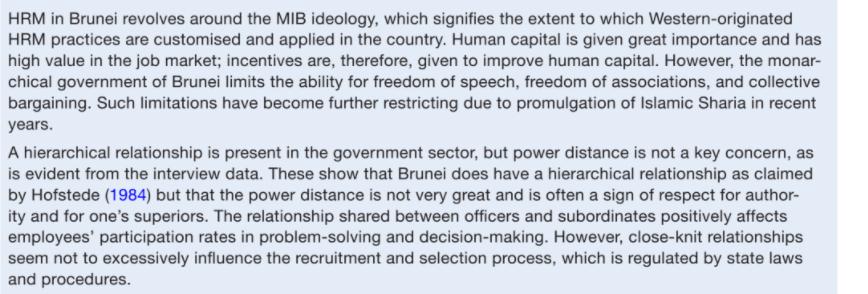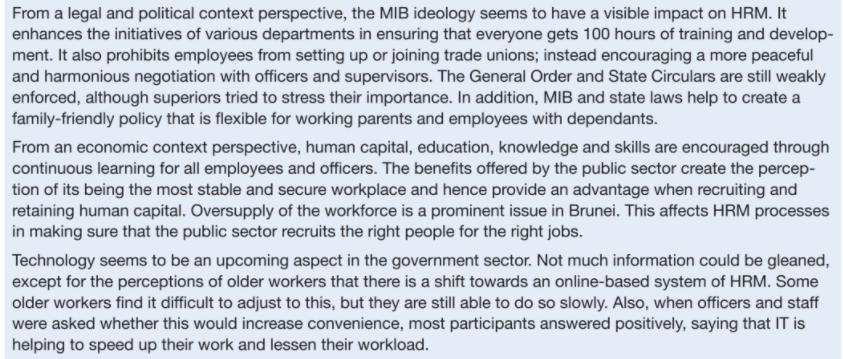Answered step by step
Verified Expert Solution
Question
1 Approved Answer
HRM in Brunei revolves around the MIB ideology, which signifies the extent to which Western-originated HRM practices are customised and applied in the country.



HRM in Brunei revolves around the MIB ideology, which signifies the extent to which Western-originated HRM practices are customised and applied in the country. Human capital is given great importance and has high value in the job market; incentives are, therefore, given to improve human capital. However, the monar- chical government of Brunei limits the ability for freedom of speech, freedom of associations, and collective bargaining. Such limitations have become further restricting due to promulgation of Islamic Sharia in recent years. A hierarchical relationship is present in the government sector, but power distance is not a key concern, as is evident from the interview data. These show that Brunei does have a hierarchical relationship as claimed by Hofstede (1984) but that the power distance is not very great and is often a sign of respect for author- ity and for one's superiors. The relationship shared between officers and subordinates positively affects employees' participation rates in problem-solving and decision-making. However, close-knit relationships seem not to excessively influence the recruitment and selection process, which is regulated by state laws and procedures. From a legal and political context perspective, the MIB ideology seems to have a visible impact on HRM. It enhances the initiatives of various departments in ensuring that everyone gets 100 hours of training and develop- ment, It also prohibits employees from setting up or joining trade unions; instead encouraging a more peaceful and harmonious negotiation with officers and supervisors. The General Order and State Circulars are still weakly enforced, although superiors tried to stress their importance. In addition, MIB and state laws help to create a family-friendly policy that is flexible for working parents and employees with dependants. From an economic context perspective, human capital, education, knowledge and skills are encouraged through continuous learning for all employees and officers. The benefits offered by the public sector create the percep- tion of its being the most stable and secure workplace and hence provide an advantage when recruiting and retaining human capital. Oversupply of the workforce is a prominent issue in Brunei. This affects HRM processes in making sure that the public sector recruits the right people for the right jobs. Technology seems to be an upcoming aspect in the government sector. Not much information could be gleaned, except for the perceptions of older workers that there is a shift towards an online-based system of HRM. Some older workers find it difficult to adjust to this, but they are still able to do so slowly. Also, when officers and staff were asked whether this would increase convenience, most participants answered positively, saying that IT is helping to speed up their work and lessen their workload. It can be concluded that local culture and politics (MIB) have a significant impact on the implementation of HRM in Brunei. We recommend that further research be conducted on a larger scale to explore the contextualisation of HRM in Brunei and other national contexts. Preferably, academia-industry partnership-based research in these government departments might allow for a deeper understanding of the topic. Questions 1 How do culture and politics affect the design and implementation of HRM in Brunei? 2 Culture serves as the overarching umbrella for all the other contexts, such as the legal and political system, the economy, and adaptation to technology. Critically discuss this. 3 How can HRM enable individual employees to adjust themselves to technological changes in their organisations? 4 How does HRM in Brunei differ from HRM in a Western country? 5 What are the likely implications of the enforcement of Islamic Sharia for HRM?
Step by Step Solution
★★★★★
3.42 Rating (146 Votes )
There are 3 Steps involved in it
Step: 1
1 Human resource management involves workforce management in organizations Due to geographical and r...
Get Instant Access to Expert-Tailored Solutions
See step-by-step solutions with expert insights and AI powered tools for academic success
Step: 2

Step: 3

Ace Your Homework with AI
Get the answers you need in no time with our AI-driven, step-by-step assistance
Get Started


